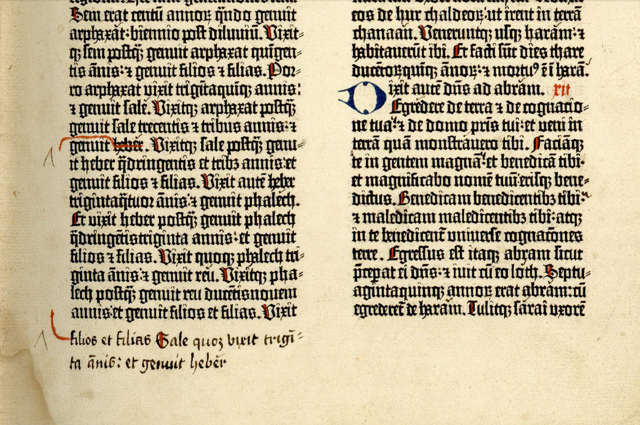Fall is here and with the turning of the leaves it is time to turn another page of the Ransom Center’s Gutenberg Bible. Our copy of the Bible is full of signs of previous readers and their interactions with the text. A rather interesting example of close reading is found in Genesis 11.

At the bottom of page 9r (left hand column) an early reader has inserted a manuscript note, adding a phrase—“filios et filias sale quoque uixit triginta annis et genuit eber”—that is missing from the printed text and indicating in red where it should be inserted.

This error was also discovered late in the printing process, and some copies of the Bible, such as both of those held by the British Library, show that Gutenberg re-set the type for this page in order to accommodate the same correction. This page in the Ransom Center’s copy is therefore an example of the earlier state of production. Below is a side-by-side comparison of the Ransom Center’s copy (the earlier state of the text) and the British Library’s paper copy (in the corrected, or later state of the text):
![Harry Ransom Center copy (left) and (c) British Library Board [C.9.d.3., f. 9r] (right)](https://sites.utexas.edu/ransomcentermagazine/files/2015/10/Side-by-side.jpg)
The error is likely due to eye-skip—a term that refers to the unintentional skipping over a word or words, often due to a repeated word or phrase, during copying by hand or when setting type from a manuscript.
The complete and correct passage should read as follows:
Porro arfaxad uixit triginta quinque annos
et genuit sale Vixitque arfaxad postquam
genuit sale trecentis tribus annis et
genuit filios et filias Sale quoque uixit triginta
annis et genuit eber vixitque sale postquam
When the compositor came to the word “genuit,” highlighted in red above, his eye skipped to the next instance of that same word just a bit further on, “genuit” in blue, and he continued setting the type. This skip resulted in the omission of the intervening underlined passage. Textual accuracy in the Bible was always of great importance, and no doubt Gutenberg was committed to producing a superior version, even if it meant re-setting the type on an entire page in order to get it right.
Squeezing in the missing line of text required the compositors to abbreviate certain adjacent words and reduce the spacing between characters—for example: in the first line of the right hand example below, the line “genuit sale quadringentis et tribus annis” has been abbreviated to “genuit sale ˜qdringétistribs ãnis” which has allowed space for extra words to be included on that line: “et genu=”. However, in the complicated job of correcting and re-setting the type in this passage, the compositors introduced another error. The first line in the excerpt below should read as it does in the left hand example “genuit sale trecentis tribus annis et.” In the later state of the text, on the right, the compositor has perhaps suffered from yet another case of eye-skip: the term “quadringentis tribus” appears in line three just below.
![Harry Ransom Center copy (earlier state) (left) and (c) British Library Board [C.9.d.3., f. 9r] (right)](https://sites.utexas.edu/ransomcentermagazine/files/2015/10/Side-by-side-2.jpg)
These differences, discovered through the comparison of multiple copies of the Gutenberg Bible and collaboration with colleagues* at fellow institutions, underscore the value of preserving multiple copies of printed books and illustrate the kinds of discoveries that arise when looking at printed books as closely as possible.
*Many thanks to my colleague Karen Limper-Herz, Lead Curator, Incunabula and Sixteenth Century Printed Books at The British Library, for her assistance in preparing this entry.
Related content
The Gutenberg Bible turns a new page
Receive the Harry Ransom Center’s latest news and information with eNews, a monthly email. Subscribe today.
